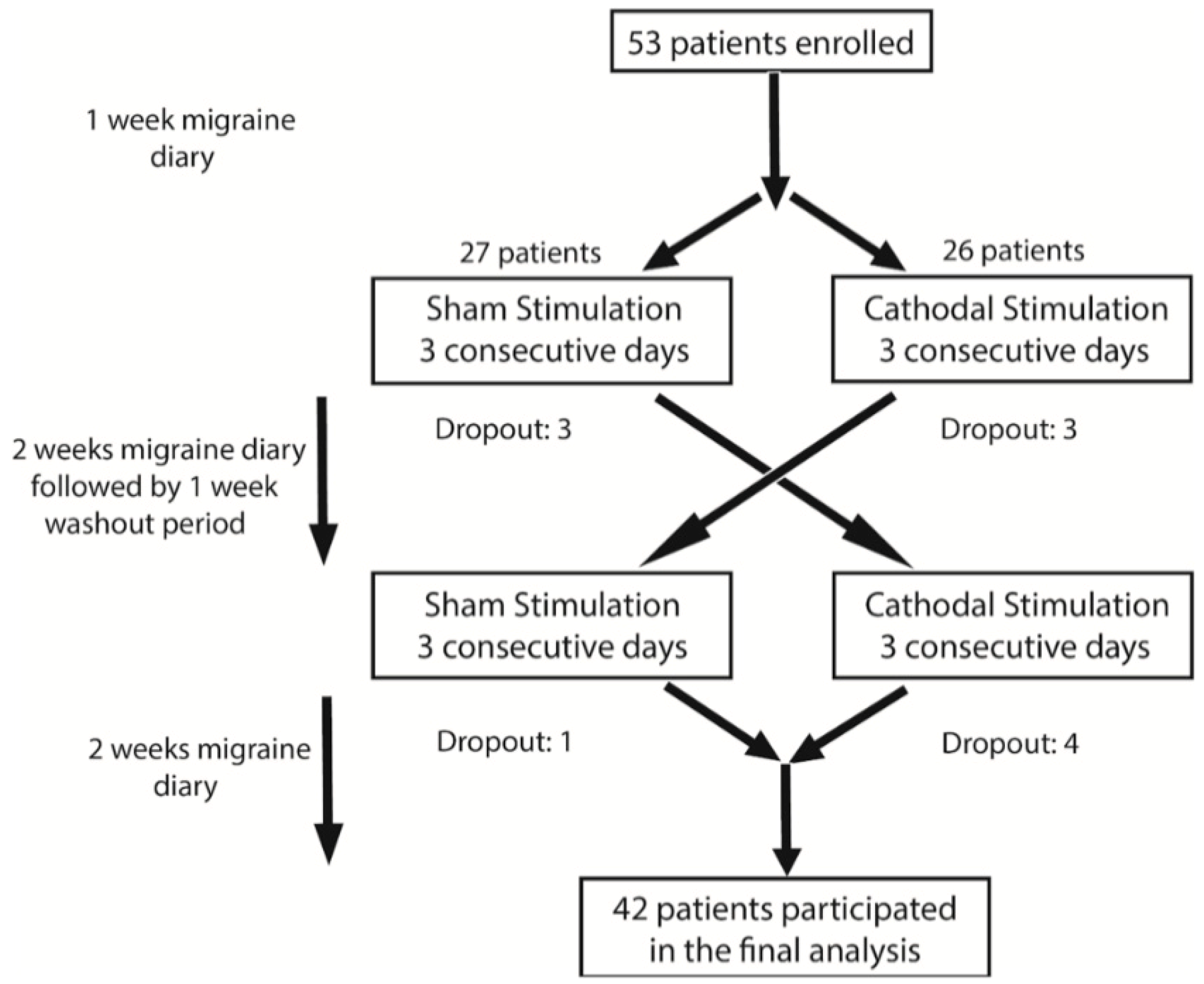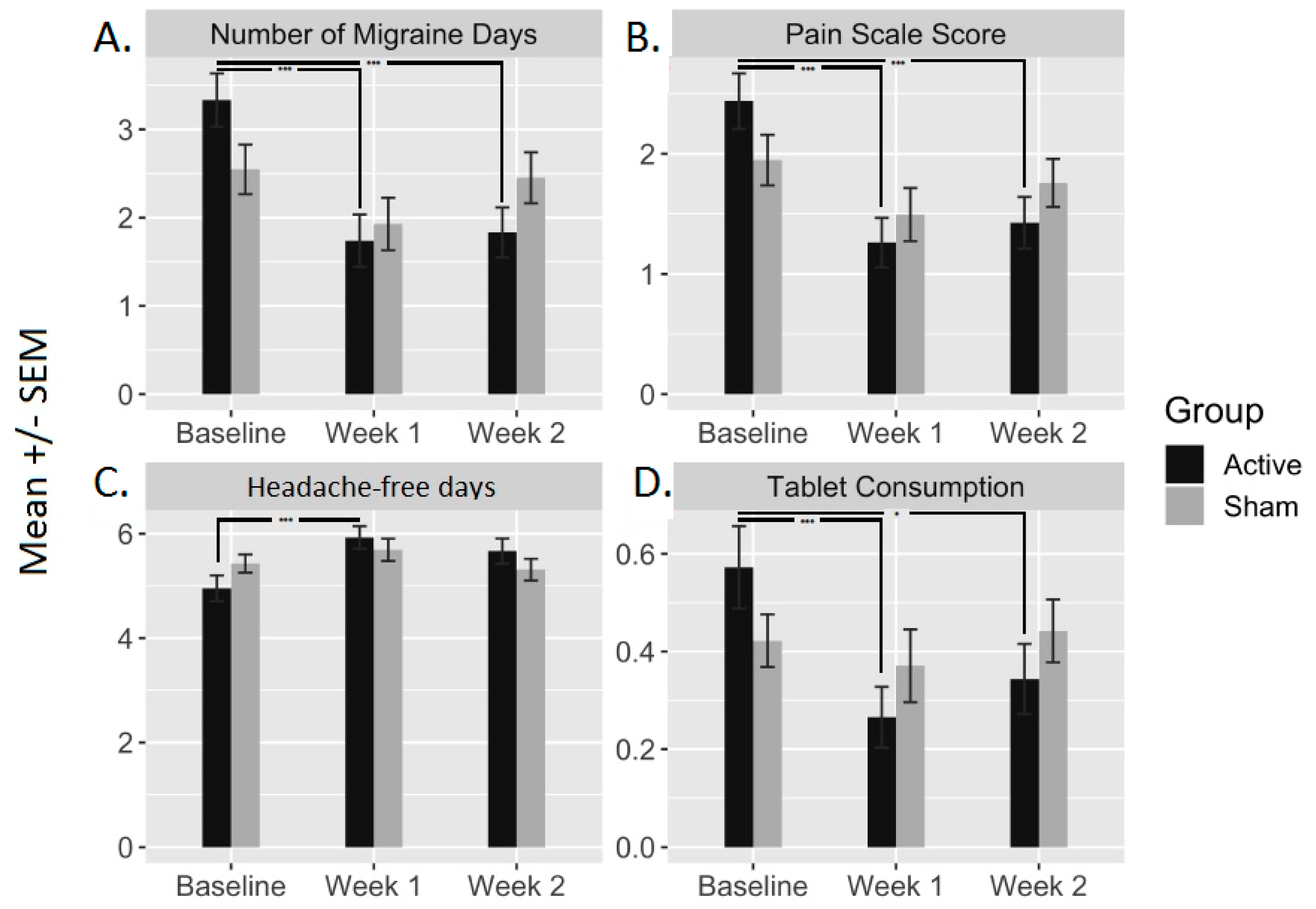Cathodal Transcranial Direct Current Stimulation of the Occipital cortex in Episodic Migraine: A Randomized Sham-Controlled Crossover Study
Abstract
1. Introduction
2. Materials and Methods
2.1. Study Population
2.2. Study Design
2.3. Study Endpoints and Output Measures
2.4. Transcranial Direct Current Stimulation
2.5. Statistical Analysis
2.5.1. Sample Size Calculation
2.5.2. Data Analysis
3. Results
4. Safety and Tolerability
5. Discussion
Author Contributions
Funding
Conflicts of Interest
References
- Headache Classification Committee of the International Headache Society (IHS). The International Classification of Headache Disorders, 3rd edition. Cephalalgia 2018, 38, 1–211. [Google Scholar] [CrossRef] [PubMed]
- Hay, S.I.; Jayaraman, S.P.; Truelsen, T.; Sorensen, R.J.; Millear, A.; Giussani, G.; Beghi, E.; GBD 2015 Disease and Injury Incidence and Prevalence Collaborators. Global, regional, and national incidence, prevalence, and years lived with disability for 310 diseases and injuries, 1990–2015: A systematic analysis for the global burden of disease study 2015. Lancet 2017, 389, 1545–1602. [Google Scholar]
- Rizzoli, P. Preventive pharmacotherapy in migraine. Headache 2014, 54, 364–369. [Google Scholar] [CrossRef] [PubMed]
- Lipton, R.B.; Bigal, M.E.; Diamond, M.; Freitag, F.; Reed, M.; Stewart, W.F.; Group, A.A. Migraine prevalence, disease burden, and the need for preventive therapy. Neurology 2007, 68, 343–349. [Google Scholar] [CrossRef]
- Starling, A. Noninvasive neuromodulation in migraine and cluster headache. Curr. Opin. Neurol. 2018, 31, 268–273. [Google Scholar] [CrossRef]
- Starling, A.J. Diagnosis and management of headache in older adults. Mayo Clin. Proc. 2018, 93, 252–262. [Google Scholar] [CrossRef]
- Bikson, M.; Grossman, P.; Thomas, C.; Zannou, A.L.; Jiang, J.; Adnan, T.; Mourdoukoutas, A.P.; Kronberg, G.; Truong, D.; Boggio, P. Safety of transcranial direct current stimulation: Evidence based update 2016. Brain Stimul. 2016, 9, 641–661. [Google Scholar] [CrossRef]
- Brunoni, A.R.; Nitsche, M.A.; Bolognini, N.; Bikson, M.; Wagner, T.; Merabet, L.; Edwards, D.J.; Valero-Cabre, A.; Rotenberg, A.; Pascual-Leone, A. Clinical research with transcranial direct current stimulation (tDCS): Challenges and future directions. Brain Stimul. 2012, 5, 175–195. [Google Scholar] [CrossRef]
- Andrade, S.M.; de Brito Aranha, R.E.L.; de Oliveira, E.A.; de Mendonça, C.T.P.L.; Martins, W.K.N.; Alves, N.T.; Fernández-Calvo, B. Transcranial direct current stimulation over the primary motor vs prefrontal cortex in refractory chronic migraine: A pilot randomized controlled trial. J. Neurol. Sci. 2017, 378, 225–232. [Google Scholar] [CrossRef]
- Antal, A.; Kriener, N.; Lang, N.; Boros, K.; Paulus, W. Cathodal transcranial direct current stimulation of the visual cortex in the prophylactic treatment of migraine. Cephalalgia 2011, 31, 820–828. [Google Scholar] [CrossRef]
- Auvichayapat, P.; Janyacharoen, T.; Rotenberg, A.; Tiamkao, S.; Krisanaprakornkit, T.; Sinawat, S.; Punjaruk, W.; Thinkhamrop, B.; Auvichayapat, N. Migraine prophylaxis by anodal transcranial direct current stimulation, a randomized, placebo-controlled trial. J. Med. Assoc. Thail. 2012, 95, 1003–1012. [Google Scholar]
- Auvichayapat, P.; Janyacharoen, T.; Tiamkao, S.; Krisanaprakornkit, T.; Thinkhamrop, B.; Auvichayapat, N. Transcranial direct current stimulation on prophylactic treatment in migraine patients, an open-label pilot study. Srinagarind Med. J. 2012, 27, 49–57. [Google Scholar]
- DaSilva, A.F.; Mendonca, M.E.; Zaghi, S.; Lopes, M.; DosSantos, M.F.; Spierings, E.L.; Bajwa, Z.; Datta, A.; Bikson, M.; Fregni, F. tDCS-induced analgesia and electrical fields in pain-related neural networks in chronic migraine. Headache 2012, 52, 1283–1295. [Google Scholar] [CrossRef] [PubMed]
- Rocha, S.; Melo, L.; Boudoux, C.; Foerster, Á.; Araújo, D.; Monte-Silva, K. Transcranial direct current stimulation in the prophylactic treatment of migraine based on interictal visual cortex excitability abnormalities: A pilot randomized controlled trial. J. Neurol. Sci. 2015, 349, 33–39. [Google Scholar] [CrossRef] [PubMed]
- Viganò, A.; D’Elia, T.S.; Sava, S.L.; Auvé, M.; De Pasqua, V.; Colosimo, A.; Di Piero, V.; Schoenen, J.; Magis, D. Transcranial Direct Current Stimulation (tDCS) of the visual cortex: A proof-of-concept study based on interictal electrophysiological abnormalities in migraine. J. Headache Pain 2013, 14, 23. [Google Scholar] [CrossRef] [PubMed]
- Paemeleire, K.; MaassenVanDenBrink, A. Calcitonin-gene-related peptide pathway mAbs and migraine prevention. Curr. Opin. Neurol. 2018, 31, 274–280. [Google Scholar] [CrossRef]
- Stoney, C.M.; Johnson, L.L. Design of Clinical Trials and Studies. In Principles and Practice of Clinical Research, 4th ed.; Elsevier: Alpharetta, GA, USA, 2017; pp. 249–268. [Google Scholar]
- Sprenger, T.; Borsook, D. Migraine Changes the Brain–Neuroimaging Imaging Makes its Mark. Curr. Opin. Neurol. 2012, 25, 252. [Google Scholar] [CrossRef]
- Antal, A.; Temme, J.; Nitsche, M.; Varga, E.; Lang, N.; Paulus, W. Altered motion perception in migraineurs: Evidence for interictal cortical hyperexcitability. Cephalalgia 2005, 25, 788–794. [Google Scholar] [CrossRef]
- Schoenen, J.; Ambrosini, A.; Sándor, P.S.; de Noordhout, A.M. Evoked potentials and transcranial magnetic stimulation in migraine: Published data and viewpoint on their pathophysiologic significance. Clin. Neurophysiol. 2003, 114, 955–972. [Google Scholar] [CrossRef]
- Coppola, G.; Pierelli, F.; Schoenen, J. Is the cerebral cortex hyperexcitable or hyperresponsive in migraine? Cephalalgia 2007, 27, 1427–1439. [Google Scholar] [CrossRef]
- Mulleners, W.M.; Chronicle, E.P.; Palmer, J.E.; Koehler, P.J.; Vredeveld, J.W. Visual cortex excitability in migraine with and without aura. Headache 2001, 41, 565–572. [Google Scholar] [CrossRef] [PubMed]
- Antal, A.; Arlt, S.; Nitsche, M.; Chadaide, Z.; Paulus, W. Higher variability of phosphene thresholds in migraineurs than in controls: A consecutive transcranial magnetic stimulation study. Cephalalgia 2006, 26, 865–870. [Google Scholar] [CrossRef] [PubMed]
- Brighina, F.; Palermo, A.; Panetta, M.L.; Daniele, O.; Aloisio, A.; Cosentino, G.; Fierro, B. Reduced cerebellar inhibition in migraine with aura: A TMS study. Cerebellum 2009, 8, 260–266. [Google Scholar] [CrossRef] [PubMed]
- Bindman, L.J.; Lippold, O.; Redfearn, J. The action of brief polarizing currents on the cerebral cortex of the rat (1) during current flow and (2) in the production of long-lasting after-effects. J. Physiol. 1964, 172, 369–382. [Google Scholar] [CrossRef] [PubMed]


| Clinical and Demographic Characteristics | |
|---|---|
| Age (mean) | 36.5 |
| Age of Onset (mean) | 23.7 |
| Gender | n |
| Male | 7 |
| Female | 35 |
| Aura | n |
| Male with Aura | 2 |
| Male without Aura | 5 |
| Female with Aura | 8 |
| Female without Aura | 27 |
| Family History of Migraine | n |
| Present | 30 |
| Medication | n |
| NSAIDs | 13 |
| Paracetamol | 23 |
| Prophylactic Treatment | 3 |
| None | 3 |
| Using OCPs | 3 |
| During tDCS | After tDCS | |||
|---|---|---|---|---|
| Adverse Effect | Active | Sham | Active | Sham |
| Headache | 14 | 7 | 14 | 7 |
| Pain | 6.3 | 3.2 | 3.2 | 2.4 |
| Fatigue | 4.8 | 3.2 | 2.4 | 1.6 |
| Disturbed Vision | 4.8 | 1.6 | 2.4 | 0.8 |
| Disturbed Concentration | 4.0 | 1.6 | 3.2 | 0.8 |
| Nervousness | 1.6 | 0.8 | 0.0 | 0.0 |
© 2019 by the authors. Licensee MDPI, Basel, Switzerland. This article is an open access article distributed under the terms and conditions of the Creative Commons Attribution (CC BY) license (http://creativecommons.org/licenses/by/4.0/).
Share and Cite
Ahdab, R.; Mansour, A.G.; Khazen, G.; El-Khoury, C.; Sabbouh, T.M.; Salem, M.; Yamak, W.; Ayache, S.S.; Riachi, N. Cathodal Transcranial Direct Current Stimulation of the Occipital cortex in Episodic Migraine: A Randomized Sham-Controlled Crossover Study. J. Clin. Med. 2020, 9, 60. https://doi.org/10.3390/jcm9010060
Ahdab R, Mansour AG, Khazen G, El-Khoury C, Sabbouh TM, Salem M, Yamak W, Ayache SS, Riachi N. Cathodal Transcranial Direct Current Stimulation of the Occipital cortex in Episodic Migraine: A Randomized Sham-Controlled Crossover Study. Journal of Clinical Medicine. 2020; 9(1):60. https://doi.org/10.3390/jcm9010060
Chicago/Turabian StyleAhdab, Rechdi, Anthony G. Mansour, Georges Khazen, Christelle El-Khoury, Toni M. Sabbouh, Maher Salem, Wissam Yamak, Samar S. Ayache, and Naji Riachi. 2020. "Cathodal Transcranial Direct Current Stimulation of the Occipital cortex in Episodic Migraine: A Randomized Sham-Controlled Crossover Study" Journal of Clinical Medicine 9, no. 1: 60. https://doi.org/10.3390/jcm9010060
APA StyleAhdab, R., Mansour, A. G., Khazen, G., El-Khoury, C., Sabbouh, T. M., Salem, M., Yamak, W., Ayache, S. S., & Riachi, N. (2020). Cathodal Transcranial Direct Current Stimulation of the Occipital cortex in Episodic Migraine: A Randomized Sham-Controlled Crossover Study. Journal of Clinical Medicine, 9(1), 60. https://doi.org/10.3390/jcm9010060






